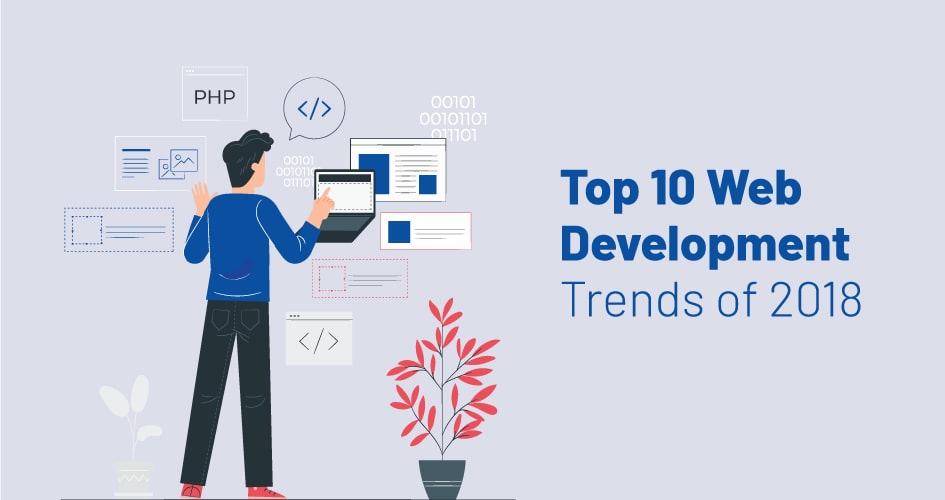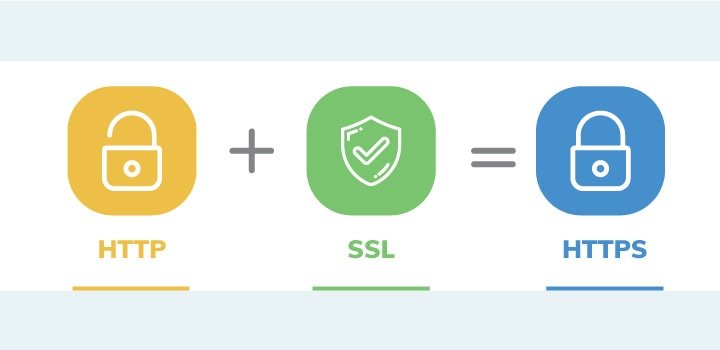Remember the days of AOL and Netscape? Web technology has grown and changed at an astounding rate since the mid-nineties, and it’s not slowing down anytime soon. It’s no surprise that mobile-friendliness and page load speed are in the front of many developers’ minds as we head into the new year.
Web development trends of 2018 include the widespread adoption of Progressive Web Applications (PWAs) and Accelerated Mobile Pages (AMPs). Both PWAs and AMPs were designed to create a faster, more user-friendly mobile experience, and web developers will see an increase in demand for this kind of web development work.
Solutions to faster page loads include newer technologies like AMPs, but some websites are experiencing enormous success by implementing older technologies. Static websites are making a return, primarily for their ability to load so quickly. Single page websites will also be a trend in 2018, for the same reason.
In the realm of development frameworks, Laravel will take the lead as the most popular PHP framework in 2018, and Angular will be the winning framework in the world of Javascript. PHP and JavaScript will remain top choices for server side (PHP) and client side (JavaScript) development.
Flash will become nearly (or completely) extinct, replaced by HTML5. More sophisticated chatbots will take over a large portion of the online customer service arena. Security will become more important than ever, and search engine rankings will be more dependent on whether or not a site implements HTTPS and SSL protocols.
Lastly, transition effects will become more subtle and artful. (Say goodbye to large, flashy animations.) Motion UI, a freestanding SASS Library, will play a large part in making attractive transition effects available to a wide variety of websites.
Want to know more? Read on for a detailed look at the top 10 web development trends of 2018.
1. Single Page Websites
In 2017, we saw a rise in popularity of a new website style, the single page website. What is a single page website?
Single page websites maintain lots of the functionality of multi-page sites, with a navigational difference: instead of a menu item taking a user to a new page, it sends the user down the current page to a new section, usually with a nifty scrolling action.
Fast load time
If designed properly, single page websites have a remarkably fast load time. When they work correctly, these pages load just the “above the fold” content when a user lands on the page, and wait to load additional content until the user actually requests it. (This type of technology is often built into multi-page sites as well, but it particularly well-suited to single page websites.)
Mobile-friendly and inexpensive
Single page websites are typically attractive, easy to navigate, and cheap to build. They also look great on mobile devices. While they’re not an ideal solution for sites that really do need a complex navigation system, like blogs or ecommerce sites, single page websites provide an attractive, easy solution for simple website projects. We’re sure to see a surge in this kind of site in 2018.
2. Static Websites
When the world wide web began, static websites were the only kind of websites. Static websites don’t make use of any scripting languages, and don’t change their behavior based on user interaction. Forget about cookies, logins, and account info – static websites are usually just html and css. Believe it or not, they’re making a comeback.
Static website speed
Why are static websites making a comeback? They’re fast. With no scripts to run, a static website is available almost instantly. Page load speed is one of the metrics Google uses to determine how well websites rank in search results, and some site owners are moving to static sites for the speed benefits. In 2018, web developers should consider the dynamic elements of sites carefully. If it doesn’t need to by dynamic, make it static!
3. Progressive Web Applications
Progressive web apps (PWAs) first hit the web in 2015, and experienced steady growth in 2016 and 2017. This kind of web application is poised for an enormous jump in popularity in 2018. So what exactly is a PWA?
Progressive web applications are websites that mimic the functionality of native mobile applications. Because native mobile applications are costly to develop and take up valuable memory on the user’s mobile device, progressive web applications are a winner for both the developer and the user.
No download or installation needed
A PWA is immediately accessible to a user the first time it’s loaded in a mobile browser – there’s no need for the user to download or install anything. Unlike traditional websites, progressive web applications are built with the ability to function even when the user has a poor network connection, or no network connection at all. “Service workers,” or scripts that run in the background on a user’s mobile device, keep the progressive web application up to date by refreshing the app’s data when the user enters an area of good network connectivity.
Increased user engagement
Large companies that have implemented a PWA version of their websites have experienced incredible increases in key site metrics (Flipkart reports a 70% increase in site conversions, and the Washington Post says that its user engagement has quintupled). Given this kind of track record, more and more websites are bound to adopt a progressive web application version in 2018.
4. Goodbye, Flash!
Did you spend a lot of time learning Flash a few years ago? Sorry about that – Flash is leaving the building. Flash’s major problem is that it’s not compatible with most mobile devices. This means that any site using Flash can’t provide a good mobile experience.
HTML5 replaces Flash for video streaming
HTML5 is now the preferred solution for tasks that used to use Flash, most notably, video streaming. Steve Jobs predicted the death of Flash in 2010, and when YouTube defaulted to HTML5 in place of Flash in 2015, web development insiders knew that Flash didn’t have much time left. In 2018, Flash will become nearly extinct. If you have any websites that still use Flash, make the switch to HTML5 as soon as possible.
5. PHP and Laravel
PHP is by far the most popular backend coding language. Approximately 83% of websites use PHP for their server-side programming. In addition, WordPress, one of the most popular content management systems, runs on PHP.
WordPress PHP 7 upgrade recommendation
PHP version 7.2 was released in November of 2017, with some coding and security improvements. Unfortunately, a huge number of WordPress sites (about 40%) are still running on WordPress 5.6, leaving them vulnerable to security problems and slower loading speeds. WordPress officially recommends that users upgrade their sites to at least PHP 7.
Laravel is the top PHP development framework
For PHP developers, Laravel, a popular open source PHP development framework, released a number of updates in 2017. With these updates (the most recent, version 5.5.25, was released on December 12), Laravel is the top framework choice for many PHP developers.
With these updates to PHP and Laravel, plus the WordPress recommendation that users upgrade to PHP7, we’re sure to see a move from the earlier versions of PHP to the more recent ones in 2018, along with an increase in general PHP usage.
6. Chatbots
Chatbots have come a long way in the past couple of years. In 2016, we started to see customer service bots on major websites, but those bots were limited to very basic interactions. A customer wanting detailed information still needed to get in touch with a human. This past year, the level of sophistication in chatbot applications rose dramatically, and many bot applications are now able to answer complicated queries and guide customers through purchase and checkout transactions.
Chatbots are an inexpensive customer service solution
Chatbots will become an essential part of commerce-related websites in 2018. Customers expect a chat window to be available to answer questions, and commerce websites can either hire a customer service team to respond to chat requests in real time, or implement a chatbot system. Chatbots are the more economical choice, and new levels of bot sophistication make them nearly as effective as human customer service agents.
Web developers should be prepared to field many client requests for chatbot integration in 2018. Clients may also have questions about artificial intelligence, and may need to be reassured that commercial chatbot applications don’t use the artificial intelligence that some people in the machine learning community view as dangerous.
7. Accelerated Mobile Pages (AMP)
The Accelerated Mobile Pages (AMP) Project is an initiative aimed at speeding up the web. As page render speed and load time become more important, web developers should be prepared to create AMP versions of web pages in 2018. It’s important to understand three of the main building blocks of AMP sites: AMP HTML, AMP JavaScript, and the AMP Cache.
AMP HTML
AMP pages use AMP HTML. AMP HTML is similar to regular HTML, but has some special AMP properties. You’ll need to use the tag to make the AMP version of your site discoverable by search engines. It’s fine to have both an AMP version and a non-AMP version of your site.
AMP JS
AMP pages make use of the AMP JavaScript Library to ensure that resources are managed in a way that prioritizes fast rendering. Resources that come from external sources are loaded asynchronously, so no page elements are prevented from rendering.
AMP JS
Google’s AMP Cache is what most people mean when they refer to an AMP Cache. Google stores AMP versions of web pages in its own content delivery network (CDN) and optimizes delivery of the page to the end users.
8. Security
As web development techniques get more sophisticated, so do hackers. Good security is not just necessary to protect a site’s users; it’s also essential for good search engine results ranking.
Benefits of SSL and HTTPS
The HTTPS (Hypertext Transfer Protocol Secure) and SSL (Secure Socket Layer) protocols ensure that any data transferred is encrypted, in addition to boosting users’ confidence that they’re communicating with their intended website and not an imposter. Google also ranks sites that use these protocols more favorably than those that use just HTTP. Many web browsers now issue a security alert when a user tries to load a page that’s not secured by HTTPS, so securing websites with SSL and HTTPS will become standard practice in 2018.
9. JavaScript and Angular
JavaScript is used in one way or another by about 95% of all websites. Because JavaScript usage is so common, any changes or developments in JavaScript frameworks are likely to set new trends.
Angular 4 and 5
Angular, already a popular JavaScript framework, came out with Angular 4 and 5 in 2017, as well as some minor updates to version 5. These versions are not complete rewrites of the previous version, Angular 2. Rather, Angular 4 and 5 introduce some new optimizations of the previous capabilities.
What do these latest versions of Angular do? They build upon Angular 2’s prioritization of mobile sites. They also run faster than Angular 2, and reduce the size of the code by about 60%. Because of these improvements, Angular will likely become the most popular JavaScript framework in 2018.
10. Site Enhancement with Motion UI
Large moving or flashing elements on websites have been deemed distracting, and they’ve been out of vogue for quite a few years. Subtle, artful animations, however, are becoming popular. Movement in response to user action is a common way to enhance a user’s experience.
Motion UI
Motion UI is a SASS Library that controls a variety of web transitions and animations. This library was originally part of the Foundation front end framework, but has been released as a standalone library. This opens the door for beautiful motion effects to be used on a variety of different sites. It’s likely that Motion UI will become the go-to library of choice for animations and transition effects in 2018.
Conclusion
There are just three words with which we can summarize ‘The Web Development Trends of 2018’ – Simple, Secure and Faster websites. As more and more users are browsing website on the go, developer’s will need to focus more on page loading speed and mobile friendly user interface.
Speak up your mind and share your thoughts in comment section below.




